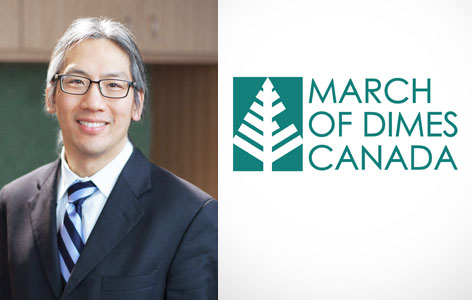Home page Description:
Dr. Chau’s research shown to improve the lives of those physical disabilities.
Posted On: August 10, 2016

Image Caption:
Dr. Tom Chau (photo taken by William Suarez; courtesy of Holland Bloorview Kids Rehabilitation Hospital)
TRI Affiliate Scientist Dr. Tom Chau has received the March of Dimes Canada’s 2016 Jonas Salk Pioneer Award for his many contributions to improving the lives of individuals with disabilities.
Dr. Chau is the Vice President of Research at Holland Bloorview Kids Rehabilitation Hospital and a world-leading researcher and educator in the field of paediatric rehabilitation. He leads the Paediatric Rehabilitation Intelligent Systems Multidisciplinary (PRISM) Laboratory, which is focuses on developing sensing, signal processing and machine-learning methods to enable children with various disabilities to communicate.
One of technologies he has developed—known as the Virtual Music Instrument—is a web-camera interface that detects motion and reflects the user’s image on a monitor, allowing the slightest of movements to produce music. It provides individuals with disabilities an opportunity to play an instrument and has been found to increase mobility in children with disabilities. The technology was licensed in 2009 and has since been adopted by rehabilitation institutes around the world.
Dr. Chau is the Vice President of Research at Holland Bloorview Kids Rehabilitation Hospital and a world-leading researcher and educator in the field of paediatric rehabilitation. He leads the Paediatric Rehabilitation Intelligent Systems Multidisciplinary (PRISM) Laboratory, which is focuses on developing sensing, signal processing and machine-learning methods to enable children with various disabilities to communicate.
One of technologies he has developed—known as the Virtual Music Instrument—is a web-camera interface that detects motion and reflects the user’s image on a monitor, allowing the slightest of movements to produce music. It provides individuals with disabilities an opportunity to play an instrument and has been found to increase mobility in children with disabilities. The technology was licensed in 2009 and has since been adopted by rehabilitation institutes around the world.




